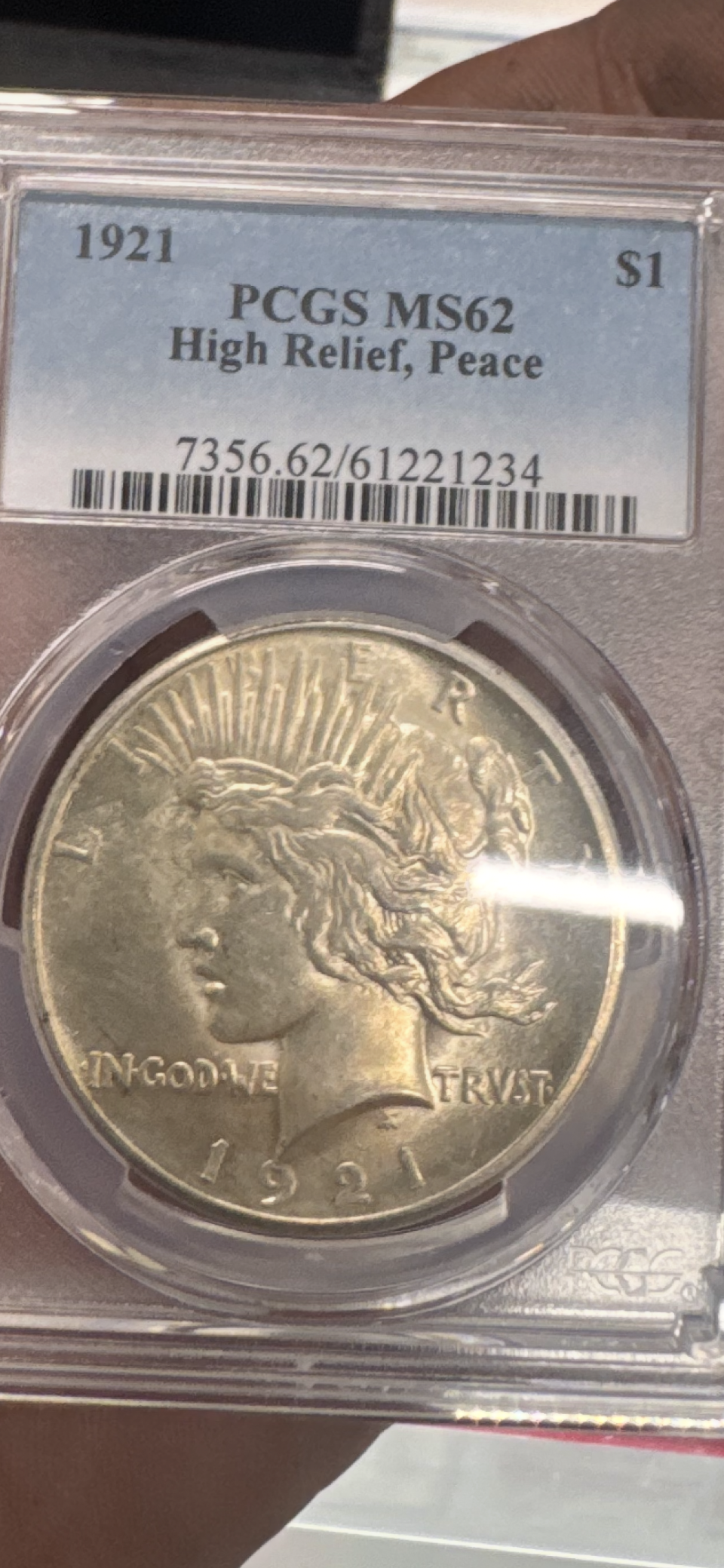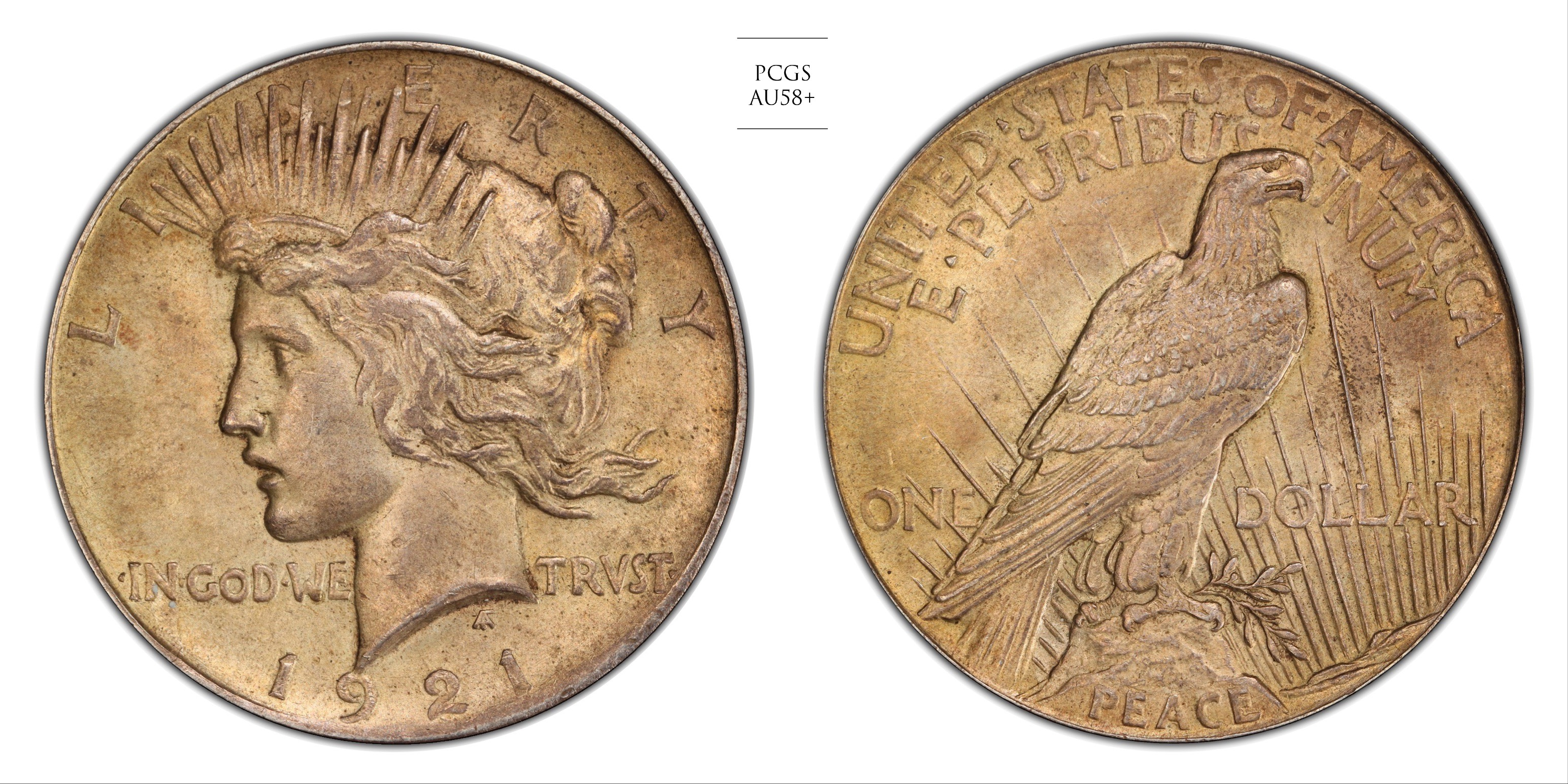Closed
 Daisy1111
Posts: 84 ✭✭
Daisy1111
Posts: 84 ✭✭
Why is strike not a significant factor in the value for the 1921’s? In my opinion it is the details that make the coin beautiful. Interested to hear everyone’s opinion.
This was my 1921 when I started this post but it’s gonna be sold to the coin shop that had it graded. Hopefully a new thread will be created instead of this one.

2
This discussion has been closed.
Comments
While the 1921 Peace dollar is known for a strike that tends to be subpar, there are many other coins with the same issue, including dates from the Buffalo nickel, Walking Liberty half dollar and Morgan dollar series. And strike can affect the grade. So there’s no necessity to take the additional step of rating a coin’s strike.
Yours does have very nice detail and some buyers will pay a premium for such coins.
Mark Feld* of Heritage Auctions*Unless otherwise noted, my posts here represent my personal opinions.
Many current collectors, including those with a great deal of money to spend, are now only concerned with the grade on the holder. They let the grading services make the decisions. Smart collectors make their own decisions and spend their hard earned money wisely.
Even though there are designations such as “FB”, “FH”, “FBL” “FS”, etc, I’m not a fan of them. As often other areas of such coins have strike weakness in other areas. By the way, in addition to the ”PL” and “DMPL/DPL” designations for Morgan dollars, these days, other coins types are awarded those designations, as well.
We all have our own particular preferences, but I generally care more about very clean surfaces than I do about strike - at least until the point that the strike is very weak. And I do agree tbat a coin graded 67 should be well struck - at least relative to the typical strike for that issue.
If you hadn’t requested that this not be turned into a grade conversation, I’d tell you that I don’t like the look of the MS67 example you posted, due to its surfaces and it’s strike.😉
Mark Feld* of Heritage Auctions*Unless otherwise noted, my posts here represent my personal opinions.
I’d argue some Proofs aren’t fully struck.
That’s a virtually impossible standard to meet for any coin. But if that’s your standard, what would you require for grades 68, 69 and 70? Better than “flawless”? Impossible.
Mark Feld* of Heritage Auctions*Unless otherwise noted, my posts here represent my personal opinions.
I don’t like the 21 Peace dollars when the hair isn’t well struck either, here’s my 58+ that I bought because I like the toning and I like that the hair is struck more than most. I wouldn’t call the hair fully struck though, I don’t think any of them are truly fully struck in that area, but when they are flat there it ruins the eye appeal for me.

Mr_Spud
Thanks. It took me about 20 years to find one I liked enough to purchase. I was close to buying others in the past, but I couldn’t bring myself to do so because they all had flat metal there where the hair should be.
Mr_Spud
@Mel2526 , the hair detail of yours in the video is better than most indeed, nice coin. I still like mine more though because of the toning, it makes it seem like it either never was dipped or only lightly a very long time ago if it was.
Mr_Spud
@Mel2526 I didn’t see distracting marks, but the luster is a bit muted like it was dipped a couple of times which might have influenced the graders. I wouldn’t call it harshly cleaned or anything like that, just it doesn’t have enough original looking skin on it for a coin that old and isn’t what some call a luster bomb like a coin that old might have if it was stored in a way that blocked humidity and gasses from making a “skin” on it.
Mr_Spud
I'm not saying your coin has or has not been dipped in the past, but I will disagree with the assertion that dipped silver "rarely" develops champagne toning afterward.
In honor of the memory of Cpl. Michael E. Thompson
How about this one? Sorry, the picture isn't professional grade - the coin is blast white.


What grades are the four bottom squares?
I think it's very difficult to refer to a 1921 Peace dollar as a full strike. While the hair around the temples is a definite focus, there are also other areas to consider; i.e., the forelock hair, the hair knob, the loose strains at the back of the neck.... On the reverse, the eagle's eye and beak. And of course it even more difficult to judge a coin from a picture as opposed to in hand. I'm just happy my coin was bought before the CAC era and later received a CAC.
Strike weakness on the reverse isn't at the eagle's feet, it's at the junction of the body and forward part of the leg. Up and left of the "D" in "DOLLAR". It's directly opposite of the place where the hair detail is an issue.
The OP's coin is above average when it comes to strike. I might have purchased it too.
The OP doesn't think the MS67 coin is graded correctly, primarily due to strike issues. I think it is graded correctly, but that doesn't mean I think it has a great strike. PCGS's own published grading criteria says 10% of the final grade is determined by strike. I think maybe I've held that 1921 in-hand. I've seen 4 or 5 of them over the years. I like other 67's better, primarily because of the toning pattern. It's OK to like different things.
Here's one I bought raw years ago. I think it has above average strike. It lives in a straight-grade NGC holder now:
@thefinn (current (???) updater of the Doily Census) has a wealth of knowledge on the history of the 1921 strike. Not sure why he has not posted here . . . . . . . .
I will see if I can alert him . . . .
Drunner
I think you are more upset about the dollar values than the strike characterisitcs. The market is what it is and people pay accordingly. I have no dispute with your emphasis on strike in this specific issue. I once built a date set of Peace dollars and quickly learned an astute buyer could get a coin with significantly more detail without having to pay much of a premium. james
I wouldn't assume that buyers who pay significantly higher premiums for toners than for well struck examples are buying the grade and not the coin. I know that's not why I'm nuch more likely to pay higher premiums for coins with great color/eye-appeal.
Mark Feld* of Heritage Auctions*Unless otherwise noted, my posts here represent my personal opinions.
I would Argue some coins labeled as Proof aren't fully stuck
11.5$ Southern Dollars, The little “Big Easy” set
Problem is more often than not, Peace dollars are an entry level series and one has to dive into the minutia to get to true scarcity which isn't really entry level collectors strong suites. The advanced collectors typically migrate to other series or high grade examples and those high grade collectors will focus on the holders and let the TPGs weight the strike and other base grade implications.
11.5$ Southern Dollars, The little “Big Easy” set
Posting this for a friend.
Some comments on Mel2526’s thread “1921 peace dollar discussion.”
The six coin composite shown in several posts is incorrectly identified. The image was copied, without attribution, from A Guide Book of Peace Dollars, Whitman Publishing LLC, by Roger W. Burdette. If the illustration had been properly attributed, members could have access the book and been better informed for the posted discussion.
The photos show, L-R, top-bottom: bronze cast of the final design (taken at US Mint by Bill Fivaz), fully struck coin; well struck coin (likely from 1st day of production), average or typical strike; below average strike, and flat strike.
The composite illustration was prepared to show central obverse detail. All the coins are uncirculated and any “grades” are irrelevant.